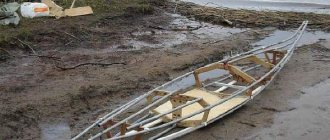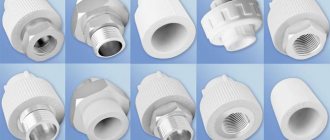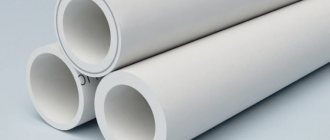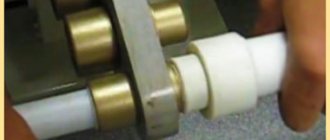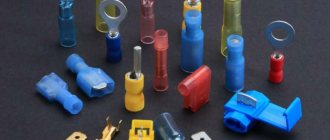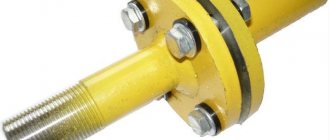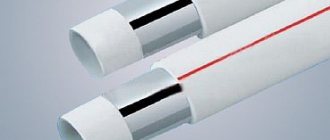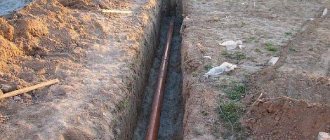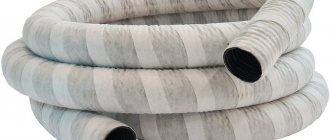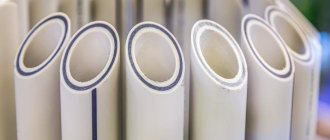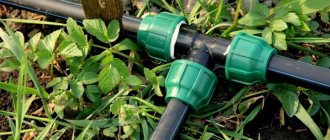Today in specialized stores you can find a wide variety of fittings for polypropylene pipes. When choosing such a modern material for laying polypropylene pipes, you need to know what types of fittings are usually used during the installation process.
Fittings are an integral attribute of pipeline installation
Main types of fittings
Fittings are usually divided by diameter and shape. The shape of the fitting determines the angle of connection. The following fittings are most often used when installing polypropylene pipes:
- couplings;
- adapters;
- corners;
- tees;
- compensators.
Now let's look at the purpose of each type in more detail:
- The coupling is the simplest type of fitting. They are shaped like a barrel with a hole inside and are used to connect pipes of the corresponding diameter.
- Adapters are also a simple type of fitting. Unlike couplings, they have different diameters at different ends, which allows you to connect pipes of different sections. If the adapter is installed from a propylene glue pipe to a threaded one, it has an internal or external thread on one side.
- Angles are used for installation at pipeline turning points. The angle allows you to create the required angle of rotation without deforming the polypropylene pipe itself. They come with a bend angle of 45 and 95 degrees, and can also combine pipes of different diameters. The corners can have external metal threads, which allows them to be connected to faucets in the bathroom or other plumbing fixtures.
- In addition, there are tees that allow you to connect several pipes on the wiring. They can have different diameters and internal relief. You can select plastic fittings that are suitable for a wide variety of pipes, including those that can connect dissimilar pipes.
Polypropylene fittings: 1 – coupling; 2 – adapter; 3 – corner; 4 – tee
If you need to run a pipeline around an object, you can use contours that avoid bending of plastic pipes.
Advantages of polypropylene
When creating a new water supply system in an apartment, many people choose polypropylene pipe products. This material, made of plastic, can be easily soldered by welding, and has a lot of other positive qualities:
- Long service life of more than 10 years. During the entire period of operation, these products are not subject to rotting and corrosion processes; plaque forms on the walls of these pipes. Provided high-quality soldering of such pipe products is performed, ideal seams and high tightness are ensured for decades.
- Water supply systems made from polypropylene pipes are easy to install. Their assembly resembles a regular construction set. During work, a minimum number of tools are used. A beginner can master soldering polypropylene pipes in one day.
- The versatility of the material. This quality of polypropylene is expressed in its wide application. It can be used to create cold and hot water supply systems. It is also often used to install heating in a home. Pipes made from this material are offered in stores in a wide range. They differ not only in their size, but also in the level of pressure that the pipe is able to withstand. The weight of polypropylene pipes is insignificant, which facilitates the process of installation work. It should also be noted that such pipes can be joined to any ends, which is how they differ from products made from other materials.
- Low price. If, when creating a water supply system, the owner’s main goal is to install a water supply system with minimal monetary costs, then polypropylene pipes are the best option.
- Convenient and affordable equipment. When creating a water supply system using polypropylene pipes, you cannot do without the use of spare parts and various accessories. There are no problems with purchasing, since they are presented in a wide range in most hardware stores. Depending on his financial capabilities, the home owner can choose affordable domestic or more expensive imported components.
About the advantages and disadvantages of plastic fittings
Among the advantages of such products are the following:
- their price is significantly lower than that of metal analogues;
- durability;
- high tightness throughout the entire period of use;
- resistance to corrosion and the formation of limescale;
- ease of installation, making it accessible for self-installation;
- There is no need for maintenance.
Video
Polypropylene pipes: types, fittings, components. Master class on pipe soldering // FORUMHOUSE
Considering that any disadvantages are a continuation of advantages, the following points should be noted:
- shut-off valves made of propylene are non-removable; if broken, the unit will have to be completely replaced;
- impossibility of adjusting the flow force with a ball valve.
Given the low price and simplicity of the replacement process, such disadvantages can be completely neglected.
Accessories for polypropylene pipes
Do-it-yourself heating installation in a private house from polypropylene pipes.
Various components are used for installing a water supply system from plastic pipes. Their assortment is very extensive and amounts to dozens of items in the price lists of manufacturers. The parts vary in shape, size and purpose. Let's look at the most common types of such elements.
A large number of components are produced for polypropylene pipes
When purchasing them, it is important to choose parts from the same manufacturer as the pipes
Couplings
The simplest connecting part. The shape resembles a small barrel, the inner diameter of the hole exactly matches the cross-section of the pipes being connected. The element is intended to connect two sections of pipe.
Couplings. The simplest connecting part. The shape resembles a small barrel, the inner diameter of the hole exactly matches the cross-section of the pipes being connected. The element is intended to connect two sections of pipe.
Adapters. These parts are designed to connect pipes of different diameters. Outwardly, they are very similar to couplings, but their main difference is that the internal diameter at the two opposite ends of the element is different.
Adapters are selected according to the diameter of the pipes being connected and come in various sizes. Parts are produced with internal or external threads, designed for transition to threaded connections.
Corners. As you know, polypropylene pipes cannot be bent. Therefore, to perform the rotations necessary during installation, the manufacturer produces special connecting parts bent at an angle of 90° and 45°.
The corners can end with holes for pipes or have threads, both internal and external. For example, such parts are used to install a mixer. Moreover, they can be either double or single.
Some home craftsmen argue that there is no need to complicate things and use corners. After all, polypropylene is plastic and can be bent. They heat the pipe to softening temperature and bend it the way they want.
Indeed, it is very easy to bend a part, but you need to understand that unpleasant changes occur in it: the wall on the outside of the bend becomes thinner. This will significantly reduce the life of the pipe and lead to its breakthrough.
A shut-off ball valve made of polypropylene is installed in the water supply using soldering
Crosses and tees. These are the names of elements designed to connect three or four pipes at the same time, which is often required for installing a water supply system. They are produced in a wide variety of variations: with hole diameters of different sizes, with fittings for other types of pipes, for example, for metal-plastic or copper, with internal and external threads of various sizes.
Contours. This is the name given to specially formed bends that are used to guide the pipe around a small obstacle. In this case, it is desirable that the distance from the pipeline to the wall be minimal. The bypass is welded into the gap in the water supply section so that the sections of pipe lying before and after it are straight.
In addition to these components, other elements are also produced. Among them are plugs used to shut off unnecessary branches of the water supply system, and special ball valves for polypropylene pipelines.
To secure the pipes to the wall, special clips are used, which are selected to match the diameter of the part. Can be single or double. Experts advise choosing pipes and components from the same manufacturer. This way there will be fewer problems during installation, and the system will be of higher quality.
For PP pipes of all sizes, a wide range of connecting parts are produced, allowing you to quickly install the plastic circuit and, if necessary, connect it to metal branches
Features of the assortment of polypropylene pipes
Diameters of polypropylene pipes
Polypropylene is a type of plastic produced by cracking petroleum products and petroleum gases. Its basis is propylene gas. Under high pressure with the presence of a catalyst, a polymerization reaction is carried out, as a result of which polypropylene is obtained. Pipes are subsequently made from it. Two types of such products are produced for water supply systems: single and multilayer.
The first option is intended mainly for various types of pipelines through which cold water is transported. Multilayer or reinforced parts are used to construct hot water lines; they are also used for the installation of heating systems. Their main difference is the presence of several layers of polypropylene, between which reinforcing material is laid.
This can be aluminum foil, polyethylene or fiberglass. The parts differ in the thickness of the reinforcing layer and base.
In the manufacture of polypropylene pipes, the following marking of the material used in production is used:
- RR-N. Products for cold water, can be used for ventilation systems.
- RR-V. Material for the production of products with high impact resistance. Designed for cold water supply and floor heating.
- PP-R. Pipes made from it can be used to install any type of water supply system.
- PPs. It is used in the production of low-flammability products intended for pipelines through which hazardous substances are transported.
The classification of materials used in the manufacture of pipeline products from thermoplastics for the construction of communications is given in GOST number 52134-2003.
Single-layer polypropylene pipes are mainly used for transporting cold water
The marking of finished products is different. The following nomenclature designations are used for polypropylene pipes:
- PN10. Products manufactured for the transportation of cold water with an operating temperature of no more than +20º C.
- PN16. Universal products that can be used for the construction of cold and hot water pipelines. However, the temperature of the liquid should not exceed +60º C. It is produced rarely, and in limited quantities.
- PN20. Pipes ensuring normal transportation of liquid tº +80ºС. By analogy with the previous type, it is considered universal.
- PN25. High pressure resistant parts can be used for both plumbing and heating. The pipes are reinforced with aluminum foil and can be used to transport water with temperatures up to +95ºС.
According to the marking of the pipes, the pressure that the PP pipes can resist when water moves through them is determined. For example, PN 10 pipes operate normally at 1 MPa, PN 20 at 2 MPa, PN 25 at 2.5 MPa.
Polypropylene is sensitive to ultraviolet radiation, so pipes are available in different colors. Black parts have the greatest resistance to UV radiation. The production of polypropylene pipes is standardized, so they are produced in certain sizes.
Multilayer reinforced pipes can withstand higher temperatures and pressures. The reinforcing layer can be made of aluminum, as in the picture, or fiberglass
The first thing you need to pay attention to is the internal and external diameters. They can be indicated both in inches and in the usual millimeters
The diameter values determine the selection of the dimensions of the fittings that will be used to connect the pipeline parts.
The outer diameter of the products varies from 16 to 500 mm. The length of the pipes can be from 2 to 5 m, which is quite enough for arranging an internal water supply system. Moreover, the products are easy to process.
The diameters of PP pipes must be taken into account when selecting connecting parts for pipeline assembly. It is assembled using detachable connections using fittings and tees (+)
Methods for connecting pipes with fittings
How to choose a machine for welding polypropylene pipes
The basic method for installing pipes with polypropylene connecting elements is polyfusion welding. For this purpose, special soldering irons are used: disk or rod. The latter is used for butt welding of pipes and fittings with a diameter of more than 63 mm. Smaller components are connected using a disk soldering iron.
Paired nozzles are installed on the heating element on both sides. The parts of the pipe and fitting prepared for connection are heated simultaneously to a temperature of 260°C. Then the parts are connected and held in this position for 10-15 seconds. Underheating, as well as overheating of the area where welding will be carried out, leads to a defective weld.
Classification of fittings
Polypropylene pipes and connecting elements are created from materials with different compositions. Therefore, they are characterized by thermal stability. This material property affects the classification and labeling of fittings and pipes.
Marking
PP pipes and fittings
PP pipeline parts are made from the following raw materials:
- Homopropylene is designated by the abbreviation PPG, and products made from it are marked PRN or PP-1.
- Random copolymer or static copolymer of polypropylene - abbreviated as PPR; when marking pipes and fittings the following designations are used: PP-3, PPRC, PPCR.
- Block copolymer (PPV) - for marking PP pipeline elements, the following abbreviations are used: RRV, RR-S, RR-2.
- Polyphenyl sulfide (PPS) - pipe parts made from it are marked (PPS).
The composition of the PPG material includes modifying additives that increase the impact strength of PP products. In addition, nucleators, fire retardants and substances that reduce static electricity.
Homopropylene is used to make pipes and fittings for external cold water supply networks, drainage and ventilation systems. The products are not used to create heating circuits for buildings because they have a low melting point.
Pipe parts made from PPG are often manufactured with large diameters. Therefore, they are used in drainage and sewer systems for industrial purposes.
Structure
The PPR material is distinguished by the crystalline structure of its molecules. Products made from random copolymer can withstand impacts and temperatures from -170°C to +1400°C.
Pipe products from this raw material are produced with a diameter of 16-110 mm. It is used for installation of heating, sewer and water supply systems in households and industrial facilities.
The PPV material is distinguished by its structure, consisting of precisely ordered homopolymer micromolecules forming blocks. Block copolymer products are characterized by high resistance to impact and high temperatures.
Therefore, heating systems in private houses and apartments are made from it. DHW and cold water circuits.
Polyphenyl sulfide has a different molecular structure and is a high-class polymer. As a result, they are characterized by excellent wear resistance, resistance to heat and heavy loads.
PPS pipes and fittings are created with a diameter of 20-1200 mm for water supply, ventilation and heating. PP products also differ from each other in their MRS characteristic - minimum duration of strength.
The indicator takes into account the wall thickness and allows you to select products based on the highest pressure in the network. Consequently, it will ensure reliable operation of the system for 50 years when moving water at a temperature of 20°C.
The maximum permissible pressure is indicated by the letters PN along with numbers. Thus, PN10 pipe elements can withstand the highest pressure load of 10 bar, and PN16 - 16 bar.
Technology for connecting polypropylene pipes
Joining and joining of polypropylene pipes can be done by exposing their ends to high temperature, by installing connecting fittings, or by gluing.
A machine for welding polymer products can be rented at a construction center
Using welding
It is impossible to connect polypropylene pipes with your own hands without the so-called “iron” - a welding machine powered by electricity.
Without the necessary skills in working with the device, it is worth practicing before performing basic manipulations. Test joints will make it possible to determine the pressure force and “catch” the optimal holding period. Therefore, materials should be purchased with a small reserve.
- In places of future joining, cuts are made on the pipes, and the ends are thoroughly cleaned. Marks are made at the ends using a marker indicating the depth of immersion of the ends into the heating device. The soldering iron itself is heated to 270°C.
- The ends of the pipes and connection elements are placed strictly perpendicularly onto the nozzles of a hot soldering iron.
- After waiting 10-15 seconds for the melt, the heated elements are removed from the nozzles and connected to each other, slightly pressing, but not turning.
- The joined parts are left in a fixed position for several minutes until they cool completely.
If everything is done correctly, then a monolithic joint without depressions or “sags” is formed at the soldering site.
When welding pipes with a diameter exceeding 40 mm, socket soldering is used. But it is better to entrust this work to a specialist who knows the intricacies of the process and has professional equipment.
Tip: To create strong units, the elements are heated from the inside and the pipes from the outside. When heated parts are joined on the inner surface of the pipes, a small bump may form, reducing the permeability of the pipe. This can be prevented by blowing out the structure.
"Cold" method
This method involves the use of compression fittings. To connect polypropylene pipes with fittings, in addition to the main elements, you only need a crimp wrench.
Tightness is achieved by a rubber seal, which is clamped with this key.
- After making cuts at the ends, check the perpendicularity of the edges. Using fine-grained sandpaper or wire wool, clean the ends from burrs.
- Place a coupling nut on the end of the pipe, directing its thread towards the fitting. After this, a compression ring is put on, placing it with a long bevel towards the fitting.
- A fitting is threaded onto the prepared end, inserting it until it stops against the inner surface of the socket.
- Tighten the coupling nut and check the system for leaks.
If a leak is detected during a test run of water, all joints are sealed and the connection is tightened.
Glue option
Unlike the welding method, which involves hot exposure, gluing of polypropylene pipes is carried out in a cold mode. The method is based on the dissolution of the outer surface of plastic elements under the influence of chemical compounds.
Glue is applied only to pre-cleaned and degreased ends
The key to the strength of connections is the correct choice of composition. When making adhesive compositions, manufacturers add substances to them that act as components of polymer pipes. Therefore, when choosing adhesives, you should give preference to compositions designed for working with polypropylene products.
The composition is applied in a thin layer, after which the parts are joined and fixed in a stationary position for 10 seconds.
The tightness of the joints of glued elements is checked after 15-20 minutes, and the pipeline is tested for strength after a day.
Shut-off valves
Shut-off valves for polypropylene pipelines are represented by ball valves and various valves. It can be made entirely of polypropylene or in a combined plastic + metal design.
The latter is selected on the basis of high corrosion resistance and durability.
Ball valves. Their purpose is to completely open or close the fluid flow through the network, that is, there are two main positions of such a device: “open” or “closed”.
Valve. This type is used as regulators of the amount of flow of working fluid; they can function in various positions, blocking or opening the cross-section of the system.
The main characteristics that the shut-off valves meet are:
- The limit for the temperature of the working fluid is 95°C, but now some manufacturers have developed modified plastics that are capable of stable operation at 110°C.
- Maximum network pressure up to 20 bar.
- The service life of cold water supply networks is 50 years.
- The same indicator for domestic hot water is 25 years at an operating temperature of 75°C.
The following types of devices have been developed and used:
- non-separable ball valve;
- dismountable design, kit includes a union nut, straight, for radiators;
- the same, corner radiator;
- ball valves with one or two detachable connections;
- valves at angles of 90 and 45o.
Shut-off valves for polypropylene pipes of the presented types are produced in gray or white. When selecting pipeline elements, single-color versions are usually completed.
Video
Elements for connecting polypropylene pipes (polypropylene fittings)
The size range of products corresponds to that for plastic pipes; as a rule, there are no problems with selection.
A distinctive feature is the installation method. Shut-off valves can have a threaded connection for use when transitioning from metal to plastic, or for soldering when connecting to plastic.
System planning
Due to the fact that PPR pipes do not bend, when developing a wiring diagram it is necessary to create as few detours and turns as possible. After all, they are all made using fittings, and they have a significant cost (compared to a pipe). Therefore, we try to optimize the wiring - make as few turns, detours and bends as possible.
Serial (Tee) connection
Installation of water supply from polypropylene pipes with serial connection of consumers (plumbing and household appliances) is used in small systems. Usually they have 5-6 connection points. With this arrangement of the water supply system, one pipe leaves the riser and it sequentially bypasses all connection points. In the case of PPR plumbing, all branches are made using tees, which is why this type is also called tee.
Installation of water supply from polypropylene pipes with serial connection of consumers
The advantage of this system is that a small number of pipes are needed, and the disadvantage is that the pressure on each branch drops. As a result, with one or two working disassembly points, the third, located further from the riser, may simply not have enough pressure.
Parallel (collector) wiring
A parallel connection circuit is also called a collector circuit. This is because after the outlet from the riser, a special device is installed - a collector. This is an element with one input and a number of outputs. Available in polypropylene and metal. For water supply, polypropylene manifolds are more suitable (and cheaper).
The connection diagram is such that a separate pipe runs from each branch to each consumer (sometimes to a small group of consumers).
Parallel scheme for installing a water supply system from PPR pipes
The advantage of such a system is that the pressure at all water points is the same, the disadvantage is that a lot of pipes are required. Another plus is that if any branch fails, only one consumer does not work. The rest of the system is functioning normally. By the way, in order to be able to turn off individual devices, valves are installed at the outlet of the collector (usually ball valves, but if you need the ability to adjust the pressure, you can install a valve).
Plumbing and household appliances
In each method of installing a water supply system made of polypropylene pipes, a pipe is suitable for a specific consumer. There are two ways to connect to the system: flexible and rigid connection.
Rigid liner is more reliable: PPR pipes and fittings have high strength. Moreover, in this case there is only one thread - at the consumer connection point. But this type of eyeliner requires high precision: the error can be only a few millimeters. This is difficult to achieve when installing a polypropylene water supply with your own hands, so flexible hoses are often used. Just be careful, in some cases it is impossible to use it: connecting gas boilers or gas water heaters, supplying water to storage water heaters, water heated towel rails is recommended only using a rigid connection.
Rigid liner options
Soft eyeliner, on the contrary, does not require high precision - errors are leveled out by a flexible stainless steel braided hose or a hose that is used to connect a washing machine or dishwasher. The tubes are removed approximately in the area where the equipment is installed or the plumbing is connected. It ends with an adapter for metal, to which a flexible hose is connected (its other end is connected to the device).
Flexible hoses are connected to the adapters
This option is less reliable, since much depends on the quality of the flexible liner. Also not the most pleasant moment is the presence of two threaded connections, and this is a potential place for a leak to appear.
Transitional coupling for reliable connection
The polypropylene transition coupling, as well as the split polypropylene coupling, are used for the installation of pipelines. It is lightweight, minimizes labor and time costs for pipeline installation, and is characterized by a long service life, practicality, durability and reliability due to the quality of workmanship and the material endowed with special properties.
The polypropylene transition coupling differs in type and diameter; it is selected based on the type and diameter of polypropylene pipes. Its feature is to ensure high connection reliability. Even after a long service life, it will not lose its properties and will clearly perform ozone functions.
How to choose
When choosing fittings, several factors should be taken into account. If after installation it is located in concrete, then stray currents will cause the destruction of the metal connection in about 18-20 years. It is for this reason that it is better to choose solder fittings for connections that will have contact with concrete. If you decide to install the water supply yourself, then it would also be an excellent solution to use such fittings. The soldering iron and fittings are inexpensive, so it doesn’t hurt to buy a few more items than you need just to practice welding them first.
If you are looking for fittings of various categories - for example, compression and crimp, then you should pay close attention to the dimensions of the walls and their thickness. In some models, the abbreviation SDR is written, which means the ratio of wall thickness and tube diameter
If this indicator differs for the specified elements, then you will not be able to do something. Either the fitting tube will be larger than the diameter of the pipe from the inside, and it will simply not be possible to install it without damaging the rubber seals, or it will simply not be possible to ensure that it is pressed tightly against the pipe and various seals.
Before choosing different models, you should ask the point of sale for a document of conformity. Everything that is produced or legally supplied to Russia must have documentation and fully comply with GOST. In addition, this will be a sign that this is not a fake. But materials that do not have documents are most likely imported illegally or created illegally, which means it is not possible to check their characteristics.
Selection of fittings by diameter
When selecting connecting elements, a diagram of the engineering system is first created. It will allow you to find out the type of fittings for polypropylene pipes. The size of each part is selected taking into account the diameters of the connected pipes in a specific area.
When choosing fittings, you need to pay attention to the markings. It allows you to find out the outer diameter, taking into account the thick walls of the elements that affect the cross-country ability. For PP parts it is less than for metal-plastic products.
Systems made of polymer materials have a smoother internal surface compared to networks made of steel. Thanks to this feature, deposits do not accumulate in PP pipelines.
Therefore, plastic communications are able to move more liquid. For example, than steel systems of identical diameter in the same time.
Indoor water supply is usually installed from PP pipes with a diameter of 20 mm. In cottages, systems may have a larger cross-sectional size, depending on the number of water points. Therefore, most often when installing a water supply system, fittings with a diameter of 20-40 mm are used.
Tees, crosses
The main purpose of the products is to join/bend several pipe bends. They are characterized by different angles and configurations. In the case of a heating system, welded fittings equipped with a smooth internal threadless surface are well used. Less often, it may be necessary to switch to another type of material, then there are threads at the ends of the connections.
Transition tee
The use of a fitting is relevant when arranging a pipeline with a transition to a smaller diameter. The operating temperature is 95 degrees, the pressure is 2.5 MPa, the connection is provided by butt welding.
Combination tee with internal thread
The product is used for connections with reinforcing elements, faucets, plumbing fixtures or steel pipes in pipeline branch areas. Operating temperature 95 degrees, pressure 2.5 MPa, butt connection.
Male Tee
Used for joining PVC pipes with reinforcing elements and steel pipes when branching pipes.
Tees with union nuts
The design is used for dismountable threaded connections of PVC pipes with steel fittings or pipes when branching pipes in areas with cold or hot water supply. The maximum heating level is 80 degrees, pressure 2.0 MPa. The connection is formed using butt welding.
Types of fittings
All products intended for building a water supply network can be classified as follows:
- Shut-off pipeline devices - include a valve to shut off the full or partial flow of the working medium.
- Regulating devices – control the throughput of the product pipeline.
- Protective valves - are activated when emergency situations occur in the network, blocking the flow of the conductive medium.
- Safety devices are designed to relieve excess pressure in the network automatically.
- Distribution - mixing - to change the direction of the ducts or mix them (mixer).
- Separating devices are used to remove products that are in different phase states, for example, steam into one pipe, water into another.
The variety of products allows you to create water supply networks of any level of complexity.
Find out how to connect a plastic pipe to a metal one, and a polyethylene pipe to a polypropylene one.
How to properly secure a pipeline
Good heating or plumbing installation is not only about the quality of the connection, but also about the implementation of knowledge on how to install assembled polypropylene pipes.
Proper fastening of plastic wiring to the walls will prevent it from sagging and deformation when heated with hot water.
When making repairs, sometimes you have to forcefully pull the pipe out of the clips, so the dowels must firmly fix this small element against the wall
For fixing pipes, the following are used: clips (single, stacked, with a clamp) and clamps (on a hairpin, paired, wall).
New models are constantly appearing on the market, so it is better to select clamps and clips directly in the store. Clips basically ensure free movement of pipes along the axis, and clamps firmly fix them in one position.
A particularly dangerous consequence of improper installation is neglecting the thermal expansion of pipes.
The length of simple PP pipes can change by 10-15mm/1m when heated. When they are rigidly fixed, deformation occurs at the adhesions, which can lead to rupture of the connection. To relieve stress, the following types of compensators are used:
- Z-shaped;
- U-shaped;
- L-shaped
- ring.
Rules for working with a compensator:
After soldering the expansion joints and attaching the pipes to clamps and clips, you can begin testing the assembled system.
Joining polypropylene pipes
If you use polypropylene pipes to install utility networks, how to connect the pipeline depends on its diameter. Polypropylene pipes PN20 and PN25 reinforced with aluminum foil with a diameter of up to 63 mm are connected by socket or socket welding. To connect straight sections, connecting couplings for polypropylene pipes are used ,
and to create threaded and other connecting assemblies - appropriate fittings with a socket.
- for cold water transfer in high pressure systems,
- in heating systems with low pressure,
- in “warm” floors.
For welding polypropylene pipes with a diameter of more than 63 mm, butt welding is mainly used, which does not require the use of additional parts. But if fittings of the required diameter are available, sleeve welding can be used. The technology for connecting large-diameter polypropylene pipes recommends a flange joint as a collapsible connection.
How to join polypropylene products using socket welding
As a tool for creating a permanent connection of PP pipes, welding machines are used, equipped with special nozzles coated with Teflon, a non-stick material. Standard nozzles have a diameter from 16 to 40 mm. During welding work, it is necessary to clean the nozzles with a tarpaulin rag or a wooden scraper after each operation.
The welding machine must be installed on a flat surface and nozzles of the required diameter must be secured to it. For connecting polypropylene pipes, the process temperature is approximately 2600C.
Heating time to solve the problem of how to connect polypropylene pipes hermetically,
depends on the ambient temperature and is 10-15 minutes.
At temperatures below zero at the work site, welding of polypropylene pipes is prohibited. The general rule regarding the question of how polypropylene pipes are connected is
that an unheated fitting should have a slightly smaller internal diameter than the outer diameter of the pipe.
The first welding is carried out approximately five minutes after heating the soldering iron. Polypropylene pipes - how to connect them using socket welding, let's figure it out together.
Using special scissors or a pipe cutter, cut the product at a right angle. The socket of the fitting and the end of the pipe are cleaned of dirt, degreased with alcohol or soapy water, and dried. The welding machine must be turned on throughout the entire welding process. Heating is carried out simultaneously for the pipe and fitting.
Underheating may cause the elements being connected to not reach the required viscous plasticity temperature. This will lead to an unreliable connection. If the parts are overheated, there is a possibility of losing their shape. If the material becomes excessively sticky, it will be difficult to connect the pipe to the fitting. When force is applied, a connection with a narrowed inner diameter is formed.
The heating time is determined by special tables; at the end of it, the parts are coaxially connected to each other with a quick movement. After welding, it is necessary to withstand the cooling time of the connected elements, especially thin-walled ones. Any deformations during this period are unacceptable. A failed connection can only be corrected by cutting out the fitting.
Connection of polypropylene pipes reinforced with aluminum foil
The connection of polypropylene with an aluminum layer has some features. To work with it, you will need a special tool - a shaver, which is used to remove the top layers of polypropylene and aluminum from the pipe. The size of the fitting socket is designed so that a pipe with the top layers removed can fit into it.
However, if you are using products, fittings and tools made by the same company, then most likely no calculations will be required. The shaver will remove the top layers exactly to the welding depth, and the size of the nozzles will not allow inserting the pipe to a depth exceeding the required one.
Main types of defects and how to avoid them
Most damage to polypropylene tees occurs when soldering them to pipes:
- Plastic flows inside the hole when parts overheat, so if possible, it is necessary to clean the hole. Otherwise, cut out the defective connection and solder again.
- Distortion of pipe with fitting.
- Incomplete soldering of the connection.
- Insufficient heating and, as a result, little contact between the pipe and the fitting. The connection turns out to be fragile and leaky.
To prevent this from happening and to avoid having to redo the entire system later, it is better to invite an experienced specialist to carry out the work. yourself, then first practice on separate sections of pipes.
